| |
“Places had great importance for me in that film. For example, I like the strange meeting in the beginning between the girl and the boy (my brother Olivier) under the pale light. Nothing special, only elements of everyday, except the girl with her strange costume, but the bizarre atmosphere is there. Why? Which? What? I don't know, but the mystery is there.” |
| |
Jean Rollin on La vampire nue, interviewed by Andy Black
and first published in Necronomicon Book One, 1996 |
Despite being only his second feature, there’s a case to be made for the 1970 The Nude Vampire [La vampire nue] as the quintessential Jean Rollin film. For those who regard Rollin simply as a director of erotic vampire tales peppered with naked young women, it’s all there in that title. For those for whom he is a filmmaker able to seamlessly blend elements of arthouse and exploitation cinema, there’s evidence aplenty to support that view in the film’s intriguing and initially baffling opening scene.
It begins without fanfare but strangely enough to have even those familiar with Rollin’s later work scratching their heads, as a young woman whose head is completely encased in a blue cloth hood is led by a hooded and lab-coated figure into a small laboratory, where two other hooded and white-coated figures are waiting. That’s not all. While the heads of two of the white-coated individuals are covered with red cloth into which holes have been cut to allow them to see, the head of the third is obscured by a black mask that resembles the head of a demonic-looking animal. While this figure stands motionless, facing away, with his arms commandingly crossed, the woman is disrobed and has blood extracted from her arm with a syringe while unidentified multicoloured liquids are distilled and shaken by the equipment in the room. Cue the opening titles, which play out over a still frame of a statue on which an unidentified male hand wearing an ornate ring is resting. I’m sorry, what?
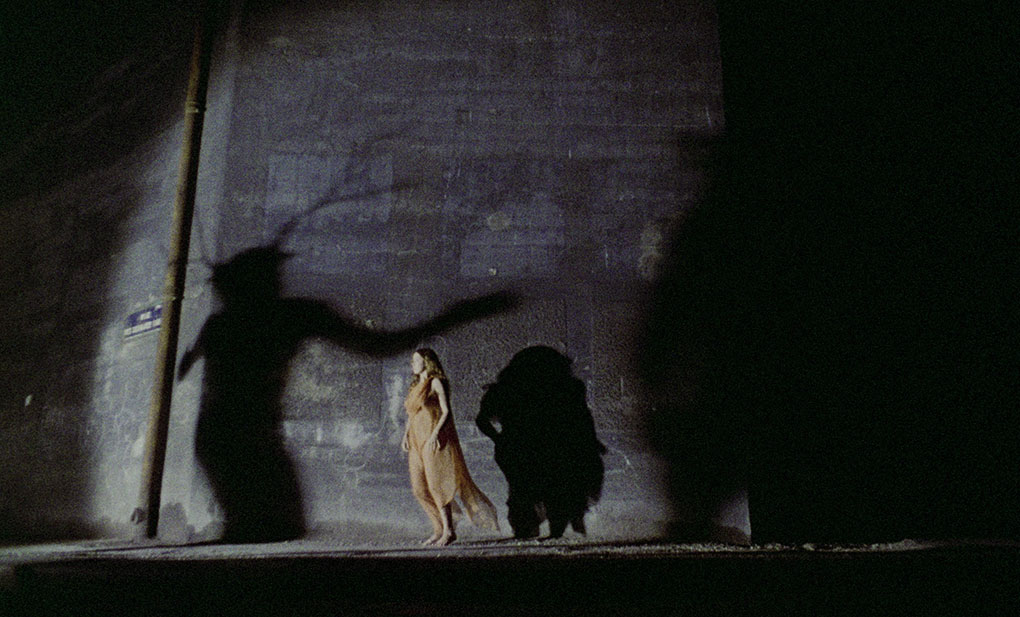
It doesn’t end there. As the titles conclude, a young Girl* (Caroline Cartier, credited here as Christine François), wearing nothing but a thin translucent red dress, edges apprehensively through the large metal gateway on the street, looking around her in a manner that suggests that she fears being discovered. It turns out she has good reason to be nervous, as she soon finds herself being followed by three figures whose faces are concealed under weird animal head masks, one bearing horns, another with a large beak, and the third sporting large and spidery antlers. As they unhurriedly but determinedly pursue the Girl, they look like creepy rejects from that climactic parade in The Wicker Man on their way to an occult-themed party with their eyes wide shut. As the Girl fearfully tries to flee from these figures – I certainly would – she suddenly comes face-to-face with handsome young Pierre Radamante (played by Jean Rollin’s brother Olivier, under the pseudonym Olivier Martin), the sight of whom halts her in her tracks. Seemingly captivated by the young man’s face, she reaches out and gently strokes it as the animal masked figures watch motionlessly on. When they start to slowly advance, Pierre grabs the Girl’s hand and the two flee together with the animal-masked figures in hot pursuit.
A short while later, Pierre and the Girl are cornered by their pursuers on railway footbridge, and when the Girl turns to face them she is unceremoniously shot dead. A shocked and frightened Pierre escapes by climbing the overhead metal framework of the bridge, leaving the masked figures to carry the body of the Girl away. Instead of fleeing, Pierre follows them to the property from which the Girl first escaped, disappearing through the secure metal gate that is firmly shut in Pierre’s face. As he waits outside contemplating his next move, a quartet of formally dressed guests arrive and are granted admittance, but when Pierre attempts to follow them in he is stopped and informed by a suited Butler (Paul Bisciglia) that only those with an invitation are allowed in. In the cinematic tradition of ‘show, don’t tell’, these are the first words spoken throughout this perplexing but strangely mesmerising opening sequence, and if you’ve managed to work out what’s going on solely from what unfolds on screen, I’m sure the scientific community will welcome your proposed adjustments to the Theory of Relativity.
The following day, Pierre’s wealthy father, Georges Radamante (Maurice Lemaître), arrives home in a strop to find Pierre lounging in a dressing gown being attended to his father’s twin sister servants (Catherine and Marie-Pierre Castel, credited here as Cathy and Pont Tricot respectively), whose breasts are barely concealed beneath impractically decorative brassieres constructed from gold wire and large metallic discs. Georges orders the girls to leave and demands to know why a cockily nonchalant Pierre was on Île Saint-Louis last night, and from the conversation that follows it becomes clear that the house Pierre was refused entry to belongs to his father. Georges angrily reminds Pierre to stay out of his business and storms off, prompting the twins to reappear and silently help the distracted Pierre to dress. Pierre then breaks the ‘show, don’t tell’ rule by loudly vocalising his thoughts and stating that he intends to investigate the private parties being held at Île Saint-Louis to discover what his father and his partners are up to. To this end, he suits up and hangs around his father’s townhouse in anticipation of the next party and ambushes one of the guests and steals his invitation. This time he is let in, despite the visual suggestion that the Butler knows exactly who he is. He even makes a point of personally showing him where to go, while being watched from above by the figure in the reindeer mask who pursued and shot the Girl.
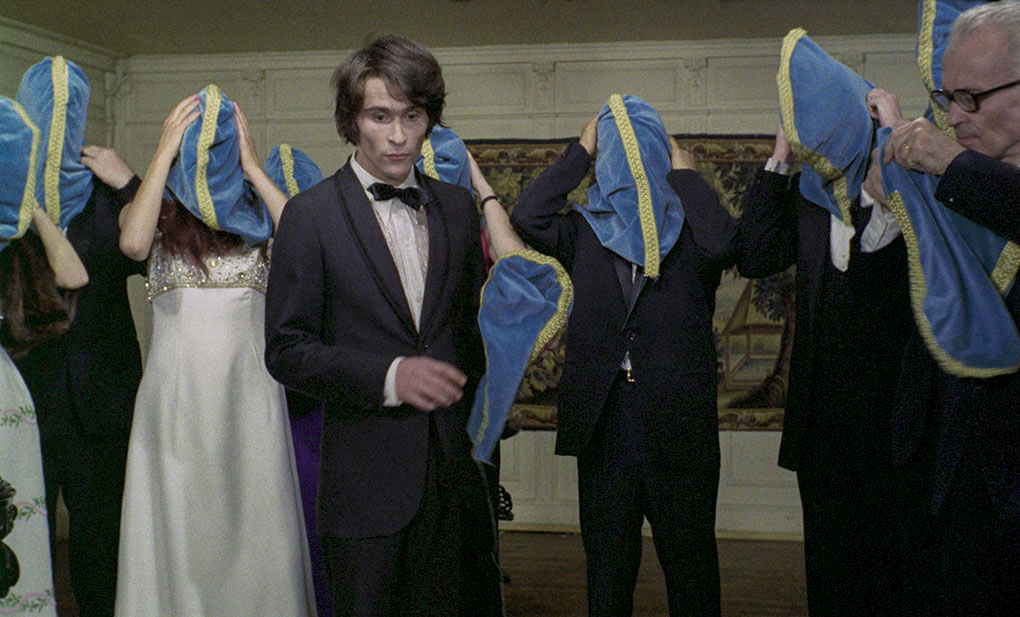
Once inside, Pierre mingles silently with the officially invited guests until they are silenced by the arrival of the Butler bearing two large crystal vases, each of which contain several small portrait photos, one of which the Butler then randomly selects and projects onto a prepared screen. The woman whose face is displayed then steps calmly forward, is handed a pistol by the doorman, and smilingly shoots herself in the head. When she falls down dead, the pistol is retrieved by the Butler, who then covers her head with the same style blue cloth hood worn by the Girl in the opening scene. The guests then all cover their own heads with identical hoods, with one also handed to a still silent Pierre for him to do likewise. Curtains are then pulled back in a wide shot that should have David Lynch nodding in warm appreciation, and two of the figures seen pursuing the Girl in the post-title scene walk in, pick up the body of the dead guest and place it on a cloth-covered table. As they stand ceremoniously either side of her with their arms folded, the Girl who was seemingly shot dead by their associate earlier slowly descends a staircase and leans over the body of the woman to drink the blood seeping from her head wound. The curtains are then closed and the ritual begins again, but this time Pierre’s face is projected on the screen...
While it may seem that much has suddenly become clear, this is all part of a smart piece of misdirection on Rollin’s part that is even embedded in what appears to be a straightforwardly descriptive title. And I know this is becoming a habit with me of late, but to elaborate further will take me into spoiler territory, so if you’re new to this film and have avoided reading anything substantial about it, you’re safe until the end of this paragraph, but I’d then give the two that immediately follows a miss. Of course, it could be argued that I’ve done my share of plot spoiling already, but at this stage we’re barely 20 minutes into film that still has over an hour to run, and the shock value of the willing suicide is dulled just a tad by the fact that neither the gun nor the unfortunate woman’s head display even a whisper of recoil or impact jolt when the shot is fired. It’s because of this that I initially assumed that she was miming and the gunshot that we heard was a diegetic sound effect, part of a pantomime of death being performed for the gathered guests. This is far from the last piece of unconvincingly mimed gunfire you’ll be seeing before the film reaches its finale, although curiously there is a single sequence where Rollin clearly had enough money for a few blank rounds. For reasons I can’t really put my finger on (but that are interestingly theorised about in the commentary), this fakery doesn’t seem to matter a jot.
Right, as indicated above, there are spoilers ahead, so to avoid them, skip past the following two paragraphs, or click here to do so automatically.
One thing that really intrigues about The Nude Vampire – an accurate translation of the original French title La vampire nue, I should note – is that viewed retrospectively, it plays less like a second feature than a late career rethink of the genre in which Rollin was to continue to work for some years to come. Here, he draws on and reworks the lore of vampire movies of years past whilst simultaneously prefiguring (and probably influencing) the wave of revisionist American genre works of the 1970s and 80s. In doing so, he sets the template for his own vampire themed films to follow in the nestling of arthouse and surrealist sensibilities within the commercially viable shell of exploitation cinema. It’s all there in that title, a sales pitch that promises what it has no intention of delivering, as the title character is never fully nude, and is ultimately revealed not to be a vampire at all. This raises the question of whether La vampire nue is actually vampire movie, as while the unnamed Girl displays many of the attributes of a classical vampire, the trait that most unequivocally defines her as one – the drinking of human blood – proves to be behaviour enforced upon her by her deluded captors.
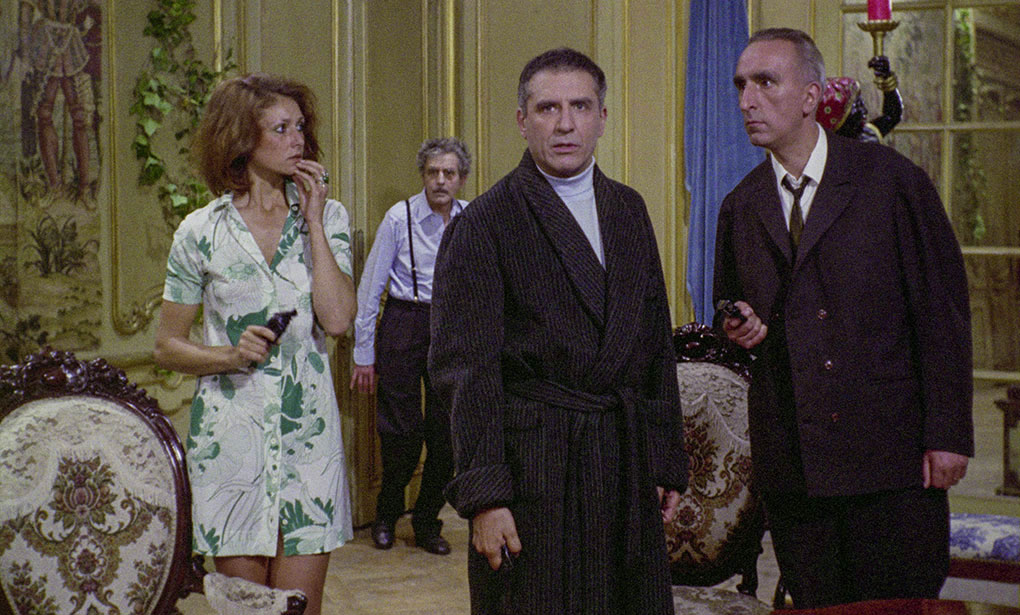
One of the real strengths and attractions of horror, and particularly vampire cinema, is its often potent socio-political subtext, an aspect of La vampire nue that, while born of the revolutionary counterculture of its age, feels as relevant as ever in a time of youth-driven protests in the face of rampant capitalistic corruption and greed. The establishment here is represented by the closed society in which Georges and his colleagues are comfortably cocooned, protected by wealth and secrecy, free to exploit those outside of their overprivileged bubble, and shamelessly lying about their intent. When directly challenged by Pierre, Georges claims that the Girl is his protégé and that he and his associates have been searching for a cure for her condition, a pretence of benevolence that disguises a far more selfish motive. This proves a fascinating and unusually scientific take on the notion of the immortal vampire, with George and his associates of the belief that if the biological component of the Girl that facilitates the healing of even seemingly fatal wounds could be identified and synthesised, they could use it to achieve immortality too, a prize that they have no qualms taking the lives of others to attain. Standing in opposition to these representatives of the state and the wealthy elite is a new generation of younger immortals, their evolutionary advancement a symbol of the idealistic struggles of politically active youth the world over, from those protesting the Vietnam War in the late 1960s and early 70s to the students occupying campuses today to protest against the ongoing slaughter of Palestinians in Gaza. Acting as their leader is an older Grandmaster (Michel Delahaye), who dresses like a Beat Generation guru and was quite possibly first of his evolutionary kind. In contrast to the members of the cult that see the Girl as a goddess for whom they will willingly and mindlessly give their lives (you won’t have to look far to find a real-life modern parallel to that one), the Grandmaster’s followers instead seek peaceful revolution, and with immortality on their side and the older generation dying out, it's only a matter of time before their dreams will be realised. That Pierre sides with the revolutionaries and is later revealed to be one of them is a further reflection of the generational gap at the heart of the political divide of the time.
Although only Rollin’s second feature, for me La vampire nue remains one of his most successful blends of arthouse surrealism and genre storytelling. It both embraces and subverts vampire movie tropes, the latter in a manner that retrospectively feels years ahead of its time, and in its final scenes there’s even an uncanny nod forward many years to the Black Lodge of David Lynch and Mark Frost’s groundbreaking Twin Peaks. In common with every Rollin film I’ve so far seen, the story seems to play out in an alternative, almost dreamlike reality, but here (almost) every seemingly inexplicable strangeness in the early scenes is revealed to have an explanation that makes sense within the otherworldly logic of the film. It sees Rollin working with colour and cinematographer Jean-Jacques Renon for the first time, a collaboration that produces some genuinely striking imagery, from the multicoloured chemical vials and beakers in the opening scenes to a sometimes haunting use of light and shadow and a high-angle wide shot of a castle courtyard, into which a small army of torch bearing individuals seem to magically materialise, that is without question one of the most breathtaking images in all of Rollin’s oeuvre.
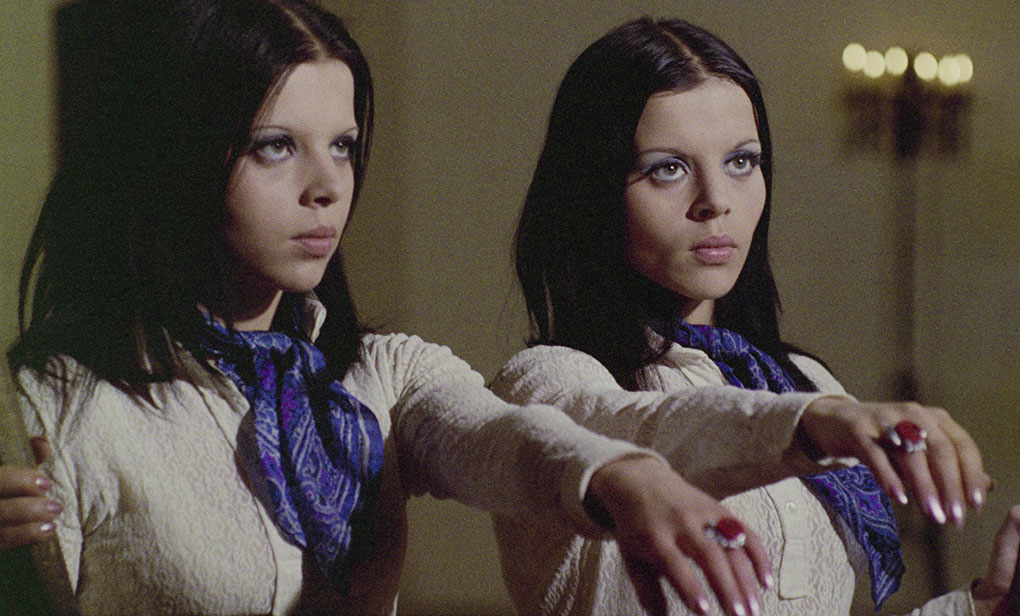
The producer pressure for nudity to help sell the film is intermittently evident, most blatantly in a sequence featuring a nude model who is posing for Pierre’s artist friend Robert (Pascal Fardoulis), which is all about the woman’s body and runs for far longer than is narratively necessary. The performances are generally robust and sometimes better than that faint praise might suggest. Although sometimes a tad wooden as Pierre, Olivier Rollin is still able to show his emotional worth when confronting his on-screen father, and I still found myself rooting for him in his determination to protect an easily likable Christine François as the Girl from whatever it is that his that her father has in stall for her. Maurice Lemaitre is convincingly arrogant as Georges, and I rather liked Paul Bisciglia’s largely silent turn as the Butler who conducts the selection ceremony. Also making a warm impression in a brief but memorable late film scene are veteran actor René-Jean Chauffard and soon-to-be Rollin multitasker Natalie Perrey, but to say anything about their roles would act as a spoiler in this spoiler-free zone. That said, the actors I found myself most entranced by were twin sisters Catherine and Marie-Pierre Castel, who play George’s unnamed servants. Their captivating looks and almost bewildering similarity aside, they feel in tune with Rollin’s visual storytelling from the moment they first appear, the dourness of their expressions communicating their dislike for a job they have probably been forced into doing, as they bide their time until the moment they can betray the man who treats them like objects to be used and abused. The wide shot in which they descend the circular stairways of symmetrically located castle towers carrying torches in perfect synchronicity, intermittently visible as they pass by identically located windows, is quietly magical.
Just two films in and Rollin was already demonstrating that he was a master of both his art and his craft. Concessions to the low budget and those holding the purse strings aside, La vampire nue is a supremely confident work from a uniquely visioned filmmaker, having the boldness and experimentation with form of his striking debut, The Rape of the Vampire (Le viol du vampire, 1968), and the smarts and genre reinvention of the American revisionist horrors of the 1970s. A gently disconcerting score from Free Jazz pioneer Yvon Gérault – who also provided music for Le viol du vampire – adds to the underlying sense of melancholic unease, and the film boasts a narrative cohesion that is rare for a director for whom atmosphere, surrealism, eroticism and a strange but beguiling otherworldliness were always more important than the mechanics of the story. Whether that’s enough to win over those otherwise unsympathetic to Rollin’s cinema is a difficult call, but if you’re already a fan of the director’s work or of revisionist, mysterious and surrealistic genre cinema in general, La vampire nue is something of a treat.
Both the original French version, La vampire nue, and the English language export version, The Nude Vampire, have been included on this disc, and as far as I’m aware (I’m sure I will be swiftly corrected if I’m wrong), there is only one major editorial difference between the two. In the La vampire nue, the film opens with the scene in which the Girl has blood taken from her arm by the three hooded figures, after which the main title sequence runs. In The Nude Vampire, this scene has been moved until afterthe title sequence, with which this version of the film begins. I’m not going to fence-sit here – where this scene sits in La vampire nue is so much more effective than in its English language equivalent. Appearing out of nowhere as it does in this cut, it creates an instant air of mystery, and is all the more disconcerting for the way it so abruptly begins, as if we’re halfway through a scene that the projectionist initially forgot to switch the lamp on for. From what I can tell, the rest of the film plays out identically in both versions, and both are the exact same length to the second.
Of course, the other key change on the export version is the English language dub, and while I’d absolutely recommend sticking with the French original, as these things go, this one is not that bad at all, being decently performed and rather well matched to the original French delivery.
We are informed by the accompanying book that La vampire nue was scanned, restored and colour corrected in 4K HDR at Renasci Films in London in its original aspect ratio of 1.66:1 using original 35mm negative materials. A combination of MTI and Nucoda DVO image processing tools were used to remove many thousands of instances of dirt, eliminate scratches and other imperfections, and repair damaged frames. We are also reassured that no grain management, edge enhancement or sharpening tools were employed to artificially alter the image in any way. This is always great to know, and when the restoration itself looks a good as the one presented here, why would you need to artificially enhance it further?
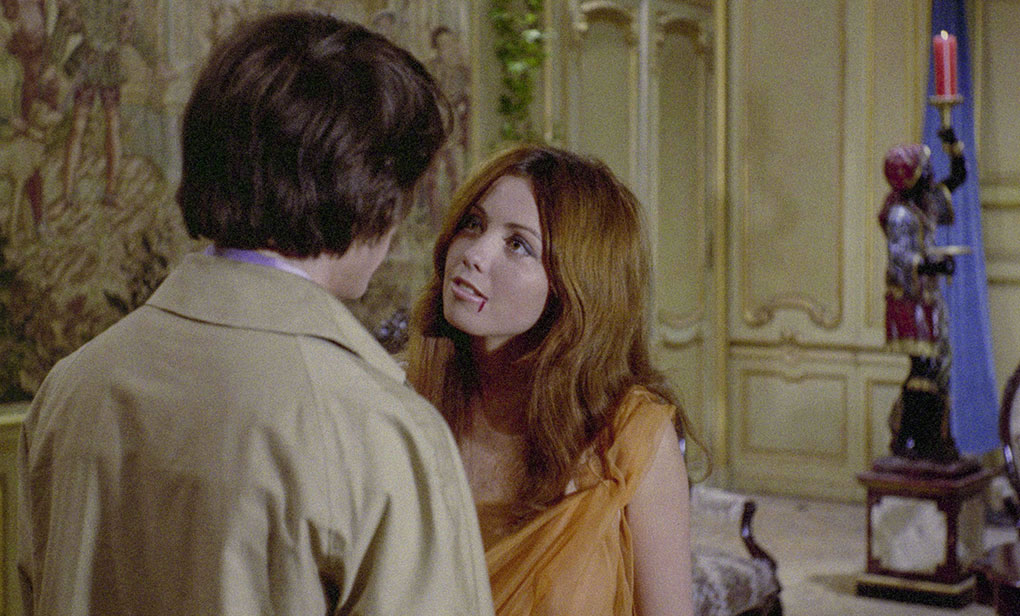
Indicator has released the film simultaneously on Blu-ray and UHD, and it’s the UHD that’s under review here, in no small part because the 4K transfer here is absolutely gorgeous. This was Rollin’s first colour film following his monochrome debut, and clearly he, cinematographer Jean-Jacques Renon, and costume designer and art director Jio Berk were keen to put the full colour pallet to visually arresting use. The opening sequence is almost a statement of intent in this regard, with rich reds and blues of the hooded masks and the brightly coloured chemicals used to test the Girl’s blood so vivid that they almost leap out of the screen, a vibrancy of colour visible throughout in the costumes, set design and lighting. The contrast is sublimely graded, with the inkiest of blacks and strong shadow detail enhanced further by Dolby Vision HDR, and the detail is crisply rendered throughout, being absolutely pin-sharp on close-up shots. There are some very faint traces of former damage if you care to look for them, but they are rare, pass fleetingly, and are barely visible. A fine film grain is evident throughout, as it should be. Seriously, Indicator is knocking it out of the park with these superb 4K Jean Rollin restorations, and this is one of the best yet – the non-HDR screen grabs here do not to it justice.
The original French mono soundtrack is presented here in DTS-HD Master Audio 1.0, and while there are some inevitable restrictions on the tonal range, the dialogue, effects and especially music are all clear and free of distortion, and there are no obvious traces of wear or damage. The English soundtrack on The Nude Vampire has a very slightly tinnier feel, but is otherwise also in fine shape.
Optional English subtitle translations are provided for La vampire nue, and optional English subtitles for the hearing impaired are available for The Nude Vampire.
Audio Commentary with Kevin Lyons and Jonathan Rigby
The regular genre duo of English Gothic and Euro Gothic author Jonathan Rigby and Encyclopaedia of Fantastic Films and Television website editor Kevin Lyons kick off with the astute observation that Rollin’s films seem to exist in their own self-contained bubbles that are not of our world, something I’ve also long felt to be true. They also warn that if the film has left you confused and you’ve looking to them to provide answers then you’ve come to the wrong place, because that’s not the point of a Jean Rollin film. Worry not, as they still find plenty to talk about here, including their respective first exposures to Rollin’s cinema, the actors and co-screenwriter Serge Moati, the influence on Rollin of filmmaker Georges Franju and painter Paul Delvaux, the paucity of available information on the cast and crew of Rollin’s films, and much more. They quote from contemporary reviews, identify Rollin’s favourite Dieppe beach location as his most recognisable star, and praise the colour and night lighting of Jean-Jacques Renon’s cinematography. There’s much more of real value here.
Jean Rollin Introduces ‘The Nude Vampire’ (5:26)
Constructed from two interviews with director Rollin – one with him reclining beside a masked figure, the other with him sitting up and bathed in red light – in which he talks about the production of and thinking behind Le vampire nue. He notes that he likes to create his own version of reality, admits that he prefers having friends around him when making a film, and recalls meeting one of the Castel twins and wanting to cast her as one of the servant girls, and then wondering where they could find another girl with similar looks. Well, as it happens…
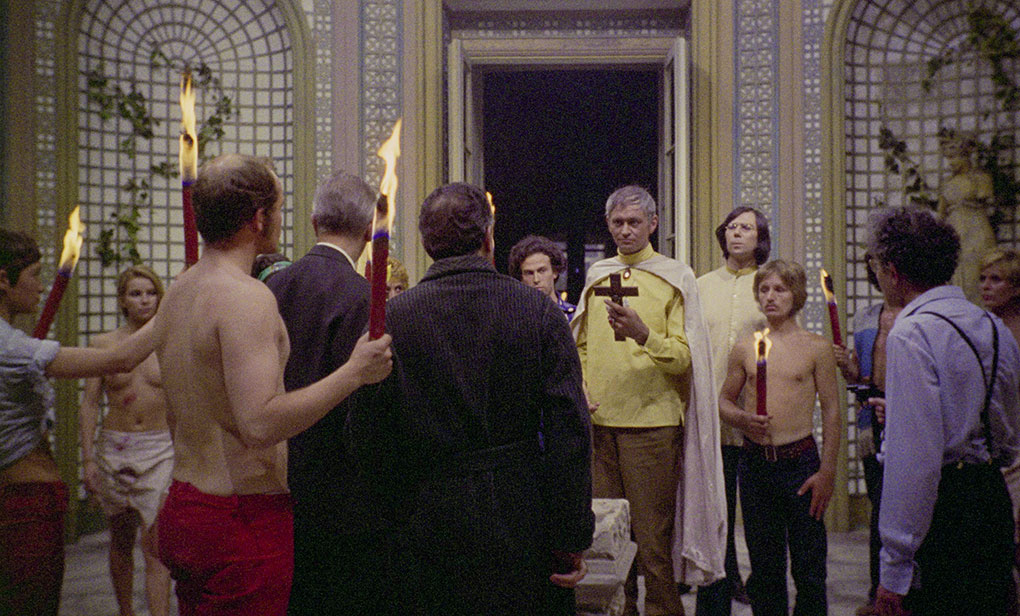
Le Passage (8:54)
A featurette made by Rollin’s personal assistant, Daniel Gouyett, in the same style as those on Indicator’s The Rape of the Vampire and Shiver of the Vampires UHDs, in which regular Rollin collaborators Natalie Perrey and her husband Jean-Noël Delamarre recall first meeting Rollin through Perrey’s last-minute casting in a crucial small role in La vampire nue. Perrey claims that you can’t deliver a bad performance when working with an actor of the calibre of René-Jean Chauffard, and notes that she was made up at the age to 40 to look just like she does now in her old age (this was filmed several years ago, as Perrey died in 2012). Writer Jean-Pierre Bouyxou then reveals that he really liked the film when it screened at Cannes and wrote an enthusiastic piece for Miroir du Fantastique, only to have his efforts cut from the magazine’s festival coverage because, the editor assured him, “all my friends who’ve seen it told me that it was abysmal, stupid.” Some people.
Jean Rollin: Fragment d’un dialogue (19:23)
Extracts from selected interviews with Rollin conducted by Daniel Gouyette between 1998 and 2003, in which he talks about his films and the reaction to them, noting that they seem to be more positively regarded abroad than in his native France. He recalls enjoying the serials that preceded features in cinemas as a child (“’To be continued…’ were magic words for us”), notes the influence of surrealism on his work, admits to not being sure why so many of his films feature two sister-like girls, and claims that he enjoys having to fight for everything when making a film, and that the results would not be as good if the process was easy. There’s plenty more of real interest here, some of which will admittedly be familiar to fans of the director’s work, particularly if you have the previous Rollin discs from Indicator.
Lucas Balbo: An Anarchist Vampire in Paris (5:26)
Archivist Lucas Balbo, speaking to camera in English in what looks like the corner of a room in his house, looks back at his introduction to the cinema of Jean Rollin through a handsome international press book for La vampire nue that his father – a printer by trade but a photographer at heart – landed the contract to print. How the job came about, and how Balbo’s father found favour with the Fédération Anarchiste is an interesting story, though I found myself wanting him to expand on the notion – which I agree with, I should note – that Rollin’s films are anarchistic because they do not respect traditional storytelling.
Virginie Sélavy: Countercultural Gothic (10:02)
Author and film historian Virginie Sélavy delivers a concise overview of La vampire nue, deconstructing the film’s counterculture subtext, highlighting the influence of Georges Franju’s 1963 Judex on the animal masks, and providing information on a couple of the key players, with particular focus on the Castel twins and the revolutionary arc of their characters.
Two theatrical trailers have been included. The Original French Theatrical Trailer (3:42) is not the snappiest on the block and bravely elects to trade on the film’s strangeness and atmosphere whilst also promising a dash of eroticism and gun violence. There are spoilers here, including footage from the finale, so save this for after your first viewing of the film, and if I’m not mistaken, there’s also a shot here that didn’t make it to the final cut. The Original English Theatrical Trailer (3:42) is exactly the same trailer but with English captions and dialogue and the export title, The Nude Vampire.
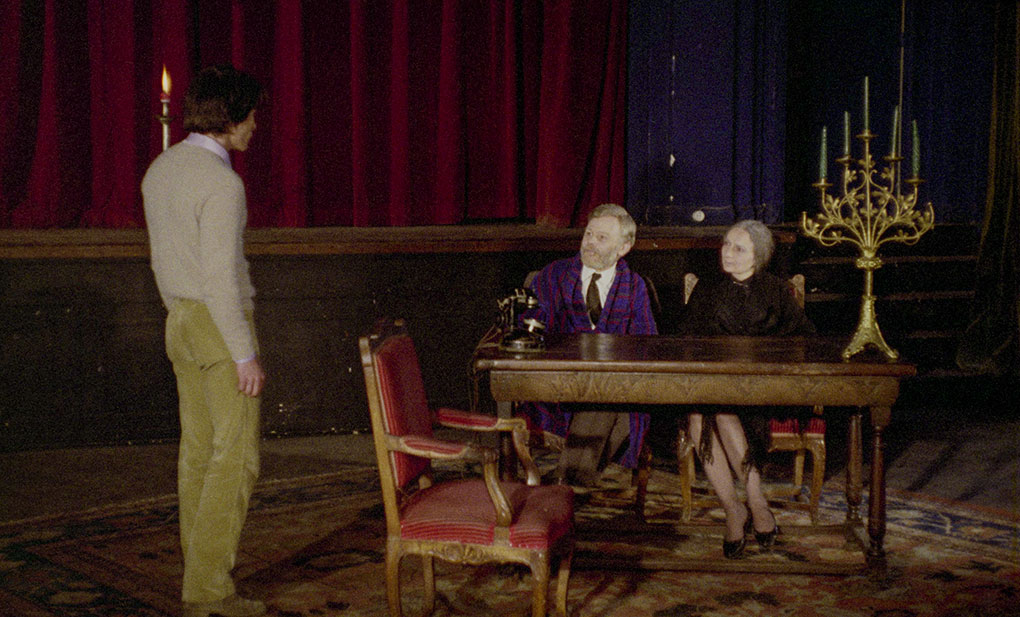
There are three Image Galleries to browse through. Original promotional Material features a generous 102 screens of monochrome and colour promotional stills, lobby cards, press book pages, video covers, and posters. Behind the Scenes has 57 screens of photos taken of the production, including several featuring Rollin with his Jacques Tati pipe, and even a few of the cinema exterior where we can presume the film premiered. Additional Photographyconsists of 41 screens of lower resolution promotional and behind-the-scenes photos.
Also included is a handsomely produced 78-page full colour Book– to differentiate a book from a booklet I’ve decided that if the pages are held together with staples then it’s a booklet, but if it’s spine-bound then it’s a full-blown book, and this is just such a creature. Following full credits for La vampire nue, there is a really perceptive essay on the film and its director by Little White Lies editor-in-chief, David Jenkins, who rather wonderfully describes the character of Pierre as “a floppy-haired Parisian pretty boy.” Next up is a 1997 introduction to the film by its director, whose opening paragraph is peppered with alarming stories, including the production running out of money, Rollin confined to bed after being hit by a car, and finding the editing room empty of all personnel after making his way there on crutches. An interview with Rollin from the Fall 1973 edition of Cinefantastique is followed by an in-depth talk with the director sourced from Necronomicon Book One: The Journal of Horror and Erotic Cinema by Andy Black, from which the quote at the top of this review was lifted. Next is a revealing piece by Jeff Billington on painter, writer, filmmaker, actor and key figure of the Lettrist movement, Maurice Lemaître, who plays Georges Radamante in the film, plus reproductions of Lettrist campaign literature. I previously knew next to nothing about Lemaître and fat too little about the Lettrist movement, so really learned a lot from this. Finally, there are extracts from contemporary critical reviews, which tend to be on the ungenerous side.
Shamefully underappreciated on its release, Rollin’s second film, for me at least, is where the style, themes, surrealism and eroticism that were to define this distinctive filmmaker’s cinema really coalesced. More thoughtfully and satisfyingly plotted than some of Rollin’s later works, it oozes atmosphere, looks terrific, and has a counterculture subtext that has gained new relevance in these increasingly turbulent political times. The restoration and transfer on the UHD are divine, and the special features are, as ever, superb. The Blu-ray is excellent, but if your system is 4K ready, then the UHD is close to perfection. Highly recommended.
|